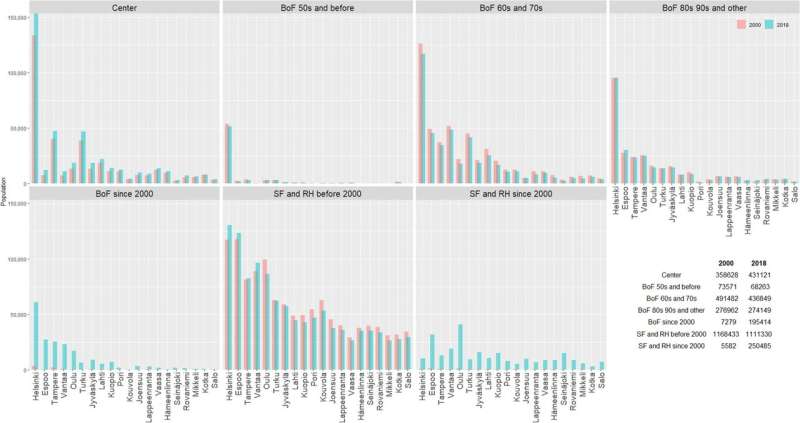This article has been reviewed according to Science X's editorial process and policies. Editors have highlighted the following attributes while ensuring the content's credibility:
fact-checked
trusted source
proofread
Sustainable urban development: How do Finnish cities compare?

A University of Helsinki study published in npj Urban Sustainability explores the development of various sustainability indicators in Finnish cities from 2000 to 2018.
Assistant Professor Sanna Ala-Mantila, the lead author of the study, says that differences between intra-city residential areas are stark, such that they also face different challenges in addressing sustainability issues. The results demonstrate that although debate on urban sustainability often focuses on denser areas with blocks of flats, a very large share of Finnish urban residents actually live in areas with single-family housing built throughout various periods.
The researchers developed a new type of classification for intra-city residential areas, dividing them into the following categories:
- Center.
- Block of flats from 1950s and before.
- Block of flats from 1960s and 1970s.
- Block of flats from 1980s and 1990s.
- Block of flats from 2000s.
- Low-rise neighborhoods built before 2000s.
- Low-rise neighborhoods built after 2000.
"Our goal was to compare the development of different types of residential areas rather than just looking at the overall picture in a given city," Ala-Mantila says.
A worrying trend
The researchers discovered that an increasing number of urban residents own a car, which means that the rate of car ownership has increased or at least remained steady in all types of areas. Population density, or the number of residents per square kilometer, has not increased significantly in any type of area or city, apart from the centers of, in particular, the biggest cities.
From the perspective of social sustainability, the employment rate is lower in areas dominated by blocks of flats from the 1960s and 1970s, or the 1980s and 1990s, than in other areas.
"Although public debate often focuses on problems affecting suburbs, that is, areas with blocks of flats from the 1960s and 1970s, our results highlight the poor development of social sustainability in these slightly more recently built areas too," notes Ala-Mantila.
The results show the wide range of residential areas in Finland and the variation in development within the various dimensions of sustainability by type of residential area. Total populations and their growth differ: city centers expansion, concurrent population decline in 1960s and 1970s suburbs, and steady populations in areas with blocks of flats from the 1980s and 1990s distinguish areas from each other in terms of how sustainability measures, for instance, affect different populations.
"Differences between cities are also interesting. For example, of the big cities studied, Helsinki has the only city center in which car ownership is below average; it is highest of all in Tikkurila, the central area in Vantaa," Ala-Mantila says.
Significance for urban planning
Ala-Mantila believes that the research results are of practical significance for urban planning, as they can be used to identify, for example, city-specific challenges affecting different types of areas. Practical interpretations based on individual indicators can support urban planning in various ways, such as resolving car ownership challenges in cities.
"The results demonstrate that the rate of car ownership is high even in new areas likely to have been planned under the principles of car-free development," Ala-Mantila states.
As residential area classification is easily replicable, it can be used in research for more in-depth exploration of other perspectives too.
"Our research is timely because urban sustainability is now a critical factor. In addition, many of the indicators examined are central for activities such as urban climate efforts, and their development is monitored and controlled in various cities. Then again, social sustainability, for example, which we studied using the indicator of employment, helps us understand the population groups affected by measures in a given area. Development indicators are often monitored for a city as a whole, disregarding differences between residential areas," says Ala-Mantila.
More information: Sanna Ala-Mantila et al, Measuring sustainable urban development in residential areas of the 20 biggest Finnish cities, npj Urban Sustainability (2023). DOI: 10.1038/s42949-023-00127-8
Provided by University of Helsinki





















